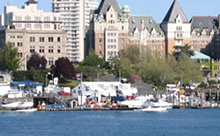 Victoria Harbour is the centrepiece of the city and its waters reflect the impressive views of the Parliament Buildings and the Empress Hotel. Victoria Harbour is a busy port and working harbour. Recreational motor and sailing vessels, fish boats, ecotourism and whale-watching vessels, car and passenger ferries to Washington State, industrial barges, and harbour water taxis and passenger ferries are some of the types of vessels that regularly use the harbour. Non-motorized recreational boats are also common including dragon boats, canoes, kayaks, rowing shells and stand-up paddle boards. Ogden Point, at the southern entrance to Victoria Harbour, accommodates large vessels such as cruise ships, coast guard vessels and fibre-optic cable repair ships. In 2019, more than 700,000 cruise ship passengers visited Victoria Harbour. The harbour also serves as a busy aerodrome, for both commercial and private flights of seaplanes and helicopters. On average, over 80 aircraft movements (departures and arrivals) occur every day. Ship-building and repair and other marine industries continue to operate in the harbour. There are several marinas, as well as harbour ferry docks and waterfront walkways.
Victoria Harbour is the centrepiece of the city and its waters reflect the impressive views of the Parliament Buildings and the Empress Hotel. Victoria Harbour is a busy port and working harbour. Recreational motor and sailing vessels, fish boats, ecotourism and whale-watching vessels, car and passenger ferries to Washington State, industrial barges, and harbour water taxis and passenger ferries are some of the types of vessels that regularly use the harbour. Non-motorized recreational boats are also common including dragon boats, canoes, kayaks, rowing shells and stand-up paddle boards. Ogden Point, at the southern entrance to Victoria Harbour, accommodates large vessels such as cruise ships, coast guard vessels and fibre-optic cable repair ships. In 2019, more than 700,000 cruise ship passengers visited Victoria Harbour. The harbour also serves as a busy aerodrome, for both commercial and private flights of seaplanes and helicopters. On average, over 80 aircraft movements (departures and arrivals) occur every day. Ship-building and repair and other marine industries continue to operate in the harbour. There are several marinas, as well as harbour ferry docks and waterfront walkways.
Virtually all of the shoreline in Victoria Harbour has been modified from its original form, with the exception of a few areas near Macaulay Point and West Bay. Although the industrial past and urban present have taken their toll on the environment, ecological values remain that are worth protecting. New developments and redevelopments along the shoreline in Victoria Harbour represent opportunities to restore some of the natural attributes of this heavily modified environment.
About Victoria Harbour
- Size (total area): 244 ha
- Total length of shoreline: 20,352m
- Depth of harbor (maximum): 21.7
- Creek that flows into the harbour: Cecelia Creek
- Number of stormwater discharges: 97
- Protected areas: Victoria Harbour Migratory Bird Sanctuary
- Species at risk: Olympia oysters, great blue heron, northern abalone
- History
Valued Habitat
Eelgrass
Some small eelgrass beds remain in the harbour, although probably much reduced in area from historic times. The largest eelgrass bed, 1.6 hectares, is located at Shoal Point. Eelgrass provides valuable habitat for many species including crabs, shrimp, and other invertebrates, as well as fish such as shiner perch, stickleback, tubesnout, rock sole, kelp greenling and buffalo sculpin. Juvenile salmon, cutthroat trout and herring shelter in eelgrass beds as well.
Kelp Beds
Most kelp occurs near rock outcrops in the outer areas of the harbour, for example around rocky islets such as Pelly Island, Sleeper Rock, Colville Is. and Berens Is., and off McLoughlin Point.